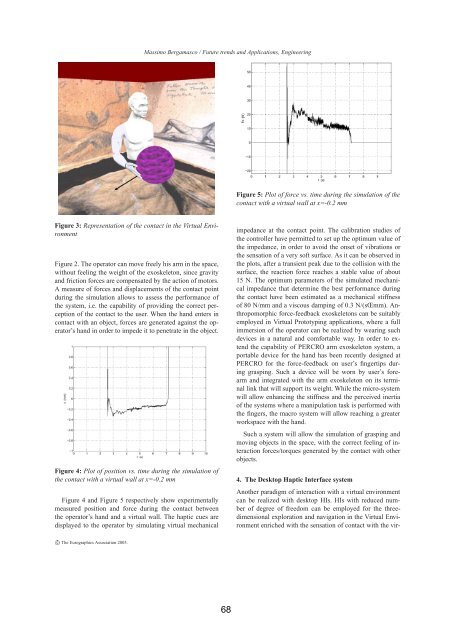full Paper - Nguyen Dang Binh
full Paper - Nguyen Dang Binh
full Paper - Nguyen Dang Binh
You also want an ePaper? Increase the reach of your titles
YUMPU automatically turns print PDFs into web optimized ePapers that Google loves.
Figure 3: Representation of the contact in the Virtual Environment<br />
Figure 2. The operator can move freely his arm in the space,<br />
without feeling the weight of the exoskeleton, since gravity<br />
and friction forces are compensated by the action of motors.<br />
A measure of forces and displacements of the contact point<br />
during the simulation allows to assess the performance of<br />
the system, i.e. the capability of providing the correct perception<br />
of the contact to the user. When the hand enters in<br />
contact with an object, forces are generated against the operator’s<br />
hand in order to impede it to penetrate in the object.<br />
Figure 4: Plot of position vs. time during the simulation of<br />
the contact with a virtual wall at x=-0.2 mm<br />
Figure 4 and Figure 5 respectively show experimentally<br />
measured position and force during the contact between<br />
the operator’s hand and a virtual wall. The haptic cues are<br />
displayed to the operator by simulating virtual mechanical<br />
c The Eurographics Association 2005.<br />
Massimo Bergamasco / Future trends and Applications, Engineering<br />
68<br />
Figure 5: Plot of force vs. time during the simulation of the<br />
contact with a virtual wall at x=-0.2 mm<br />
impedance at the contact point. The calibration studies of<br />
the controller have permitted to set up the optimum value of<br />
the impedance, in order to avoid the onset of vibrations or<br />
the sensation of a very soft surface. As it can be observed in<br />
the plots, after a transient peak due to the collision with the<br />
surface, the reaction force reaches a stable value of about<br />
15 N. The optimum parameters of the simulated mechanical<br />
impedance that determine the best performance during<br />
the contact have been estimated as a mechanical stiffness<br />
of 80 N/mm and a viscous damping of 0.3 N/(sŒmm). Anthropomorphic<br />
force-feedback exoskeletons can be suitably<br />
employed in Virtual Prototyping applications, where a <strong>full</strong><br />
immersion of the operator can be realized by wearing such<br />
devices in a natural and comfortable way. In order to extend<br />
the capability of PERCRO arm exoskeleton system, a<br />
portable device for the hand has been recently designed at<br />
PERCRO for the force-feedback on user’s fingertips during<br />
grasping. Such a device will be worn by user’s forearm<br />
and integrated with the arm exoskeleton on its terminal<br />
link that will support its weight. While the micro-system<br />
will allow enhancing the stiffness and the perceived inertia<br />
of the systems where a manipulation task is performed with<br />
the fingers, the macro system will allow reaching a greater<br />
workspace with the hand.<br />
Such a system will allow the simulation of grasping and<br />
moving objects in the space, with the correct feeling of interaction<br />
forces/torques generated by the contact with other<br />
objects.<br />
4. The Desktop Haptic Interface system<br />
Another paradigm of interaction with a virtual environment<br />
can be realized with desktop HIs. HIs with reduced number<br />
of degree of freedom can be employed for the threedimensional<br />
exploration and navigation in the Virtual Environment<br />
enriched with the sensation of contact with the vir
















